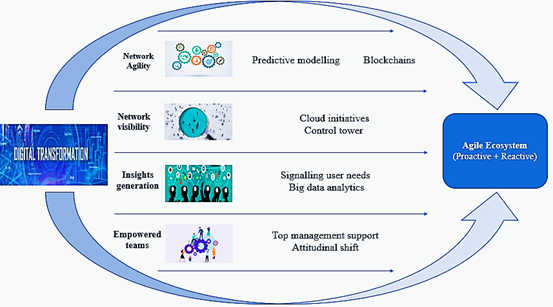The transformation of competition from individual firms to entire supply chains, coupled with the rise of various technologies and significant shifts in customer expectations, has necessitated the development of strategic approaches prioritizing swift delivery and rapid response times. In recent years, there has been a notable increase in the prevalence of the concept of "ecosystems" within business discussions. In this context, an ecosystem refers to a strategic framework where multiple entities collaborate to create mutual value by integrating resources. Business leaders increasingly recognize that the most valuable skills and ideas within their industry often exist beyond the boundaries of any single organization. Consequently, there is a growing emphasis on collaboration as a key driver of success, albeit one that presents unique challenges.
Industry agility
Amid the ongoing challenges posed by phenomena such as Industry 4.0 and other disruptions (including war & pandemic), the agility of these ecosystems has become paramount. In this context, agility is characterized by the ability to rapidly adapt to changing circumstances, particularly through the reduction of information lead time among ecosystem members. In dynamic markets characterized by rapid technological advancements, traditional advantages such as stable boundaries or customer bases are no longer sustainable. Instead, success hinges on the continuous creation of temporary advantages and the ability to quickly reconfigure resources in response to market shifts.
The agility of an ecosystem rests on two main pillars: proactiveness and reactiveness. Proactiveness involves anticipating and seizing opportunities or mitigating threats, often facilitated by market sensing and predictive technologies. This proactive stance fosters closer relationships with customers, enabling swift detection of changes in demand and the extension of customer value. Conversely, reactiveness entails the capacity to swiftly adapt to unforeseen events, serving as a defensive mechanism against disruptions. A significant transformation of business processes and operations is imperative for business leaders to effectively embrace agile ecosystems. This transformation often involves leveraging innovative digital technologies, such as cloud computing, data analytics, and the Internet of Things (IoT), to enhance flexibility and responsiveness. By prioritizing digital innovation and knowledge-sharing among ecosystem members, organizations can enhance their learning capabilities and, consequently, their ability to anticipate and meet customer needs.
Agility flies at Emirates
Emirates Airlines is a compelling example of a company that has embraced an agile ecosystem. Emirates has positioned itself at the forefront of digital readiness within the airline industry through strategic partnerships with leading technological firms and a comprehensive digital transformation strategy. By placing data at the core of its operations and leveraging technologies such as virtual reality, predictive analytics, and artificial intelligence, Emirates has achieved significant operational efficiencies and customer satisfaction improvements. From enhancing in-flight services to optimizing maintenance procedures, Emirates' agile ecosystem approach has yielded tangible operational performance and sustainability benefits.
While digital transformation is integral to enabling agile ecosystems, it is essential to recognize that success ultimately hinges on transformative capabilities and a collaborative mindset. Rather than simply adopting new technologies, organizations must foster a culture of value co-creation and continuous adaptation, as depicted in Figure 1. This collaborative ethos ensures that agile ecosystems remain responsive and resilient in evolving market dynamics.

Figure 1. Capabilities needed for the agile ecosystem
Establishing an agile ecosystem
The concept of an agile ecosystem entails establishing pervasive networks, digitizing supply chains, and embracing the latest tools of Industry 4.0. Digital transformation plays a pivotal role in fostering trust within these networks. This necessitates the continual modernization of supply chains, incorporating various technologies to enhance collaboration and trust. Technologies such as AI-guided wearables for picking and packing, blockchain-enabled customer order ledgers, and IoT-connected machines on the factory floor constitute a dynamic yet intricate infrastructure that organizations must integrate into their ecosystems to maintain agility. These technological innovations facilitate predictive capabilities and provide stakeholders timely notifications of changes or potential disruptions. Blockchain technology, for instance, offers a decentralized ledger system where immutable terms and conditions instill a higher level of trust. This networked environment enables anticipatory shipping, exemplified by Amazon's ability to dispatch products before customer orders.
Real-time tracking
The onset of global disruptions due to war, price inflations, and the pandemic-intensified pressure on product supply chains, underscore the importance of real-time product tracking for enhancing flexibility and network resilience. In today's competitive landscape, reactive decision-making alone is inadequate; proactive strategies often dictate success or failure. Network visibility empowers managers with alerts and insights into potential setbacks, enabling swift deployment of contingency plans to mitigate adverse effects. Technological innovations such as blockchain, artificial intelligence, and IoT enhance visibility into demand requirements, amplifying agility. Given the virtual orientation and integrated nature of agile ecosystems, the seamless exchange of information among members facilitates swift adaptation to new services, procedures, and capabilities. This heightened network visibility enables providers to respond promptly, enhancing overall customer service levels. Embracing network-based supply chain control tower strategies encompassing the entire business network—including suppliers, customers, and other partners—can realize the elusive goal of end-to-end visibility.
The rapid generation of insights is a pivotal capability for business leaders to cultivate an agile ecosystem, a goal further catalyzed by digital transformation. Ongoing technological advancements, shifts in market dynamics, and evolving consumer preferences frequently render existing products and services obsolete, necessitating swift adaptations within firms' offerings. A cornerstone capability for innovation lies in effectively discerning user needs through intensive client engagement. This practice proves paramount for consistently furnishing novel offerings and enhanced experiences, particularly within sectors characterized by high unpredictability and diversity.
How to thrive
Innovative products, characterized by dynamism, profitability, and susceptibility to rapid shifts in demand, thrive within agile ecosystems. Leading firms across various industries are establishing specialized data units, overseen by senior executives, to aggregate, analyze, and disseminate data throughout the organization and its ecosystem partners. Leveraging predictive analytics, powered by historical data, machine learning, and artificial intelligence, facilitates anticipating future trends, thereby expediting insight generation. Crucially, the unwavering support of top executives is imperative in propelling the ethos of agility and digital transformation forward. This support extends across all endeavors to revitalize organizational practices, procedures, mechanisms, systems, and models, fostering decentralized teamwork, information dissemination, coordination, collaboration, and learning—all pivotal strategic enablers within an agile ecosystem. Embracing requisite technological advancements necessitates a paradigm shift, underscoring the importance of top-level executives embracing a holistic and integrated approach to adaptation. It is incumbent upon them to envision how digital applications can streamline cross-functional processes and services.
The indispensable nature of an agile ecosystem remains ever apparent. Agility emerges as a linchpin in enabling firms to adeptly navigate changes with efficiency, reliability, effectiveness, and celerity, with digitalization emerging as the pathway to achieve this goal. The imperative of digital transformation in fortifying the agile ecosystem, particularly amidst the backdrop of global disruptions, is underscored. Frequent iterations of products and services, coupled with innovative processes, technologies, and administrative methodologies, collectively bolster the sense-and-response capabilities of the agile ecosystem, especially within contexts characterized by uncertainty. The fluidity of risk measures worldwide has necessitated a reevaluation of business models and a shift toward digitized interactions to revitalize enterprises. Indeed, the agile ecosystem has emerged as a sine qua non in response to the escalating demands of the global market for firm competitiveness. It epitomizes the ability to swiftly adapt to complex market shifts and deliver tailored products with requisite features. At its core, the agile ecosystem embodies innovative thinking, enabling managers to adopt a systemic perspective wherein all stakeholders contribute to value propositions. Managers aspiring to embrace the agile ecosystem should prioritize investments in nurturing relational assets through digitization while actively engaging customers as the ultimate beneficiaries who delineate value.
About the authors:
Eias AI Humdan, Department of Management, Macquarie Business School, Macquarie University, Australia. Masud Behina, Department of Management, Macquarie Business School, Macquarie University, Australia. Yangyan Shi, School of Economics and Management, Shanxi University, China as well as in the Department of Management, Macquarie Business School, Macquarie University, Australia. V.G. Venkatesh, EM Normandie Business School, METIS Lab, France.
SC
MR


More Supply Chain Management
- Retail sales see gains in October, reports Commerce and NRF
- Balancing green and speed: Home delivery insights from the pandemic era
- AdventHealth named top healthcare supply chain by Gartner
- Unlocking retention: The role employee engagement plays
- Can supply chain managers embrace an entrepreneurial mindset?
- Challenges to ESG reporting
- More Supply Chain Management
Latest Podcast

 Explore
Explore
Business Management News
- Made in Mexico, manufactured by China
- Retail sales see gains in October, reports Commerce and NRF
- Balancing green and speed: Home delivery insights from the pandemic era
- AdventHealth named top healthcare supply chain by Gartner
- Unlocking retention: The role employee engagement plays
- Can supply chain managers embrace an entrepreneurial mindset?
- More Business Management
Latest Business Management Resources

Subscribe

Supply Chain Management Review delivers the best industry content.

Editors’ Picks




